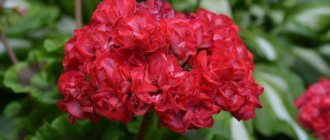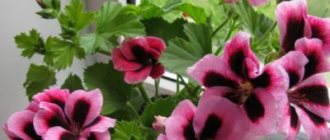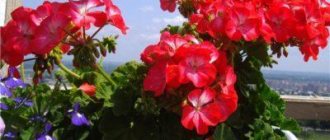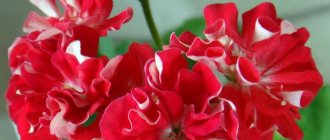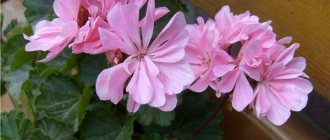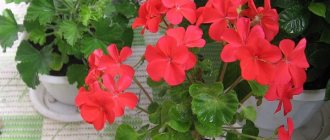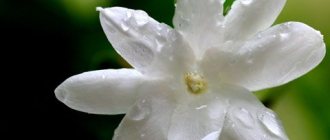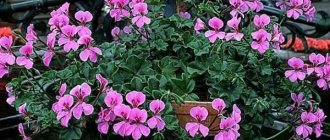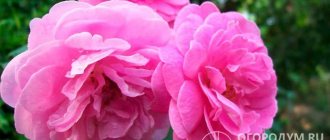Why do I grow geraniums in open ground?
Geranium is one of my favorite flowers, so it’s no secret that it brightens up my garden. Pelargonium is not only beautiful and bright, but also unpretentious in comparison with the “queen of the garden” rose. But when choosing a new variety, I study the description - the plant must be adapted to our climatic conditions.
perennial garden geranium
If you decide to grow geranium in your flower garden for the first time, I can recommend several varieties that you will definitely like:
- Ashy. I’ll start with the most unpretentious variety of geranium - it takes root well not only in the middle zone, but also in the northern regions. A low plant with ash-colored leaves - hence the name. The flowers themselves are bright pink with white centers. Ash pelargonium is preferred for decorating borders.
- Lugovaya. This geranium with the largest inflorescences is like blue saucers! I recommend this variety for open, sunny areas. Do not choose meadow geranium unless you can provide the plant with consistent, frequent watering.
- Himalayan. The most versatile pelargonium you will find in garden stores. It is used to decorate gazebos, plant them along borders, and on flower beds as a continuous “carpet.” Himalayan pelargonium blooms well and develops even in shaded areas. And the esthete’s eye will be delighted by its raspberry-lilac double blooms.
- Clark's geranium. An excellent choice for owners of plots in lowlands, where there is a high degree of humidity even in dry summers. Clark's Pelargonium is a plant with thin stems and beautiful large leaves. The petals of the inflorescences are soft blue, pleasant purple.
- Spotted. It grows into a large bush, rising 50 cm. The flowers are real snow-white or blue “bowls”. For spotted pelargonium to develop well, plant it in an open, well-lit area.
Features of the plant
Geraniums first settled in the garden back in the days of ancient Greece. Gardeners noticed its resemblance to a bird's beak and nicknamed it “geranion,” which means crane. There is a legend that crops with openwork leaf blades were cultivated in the gardens of Dioscorides. It was from there that the plant moved to European countries. Since the Middle Ages, people have noticed the healing properties of the culture and began to use it in medicine.
An amazing plant appeared in Rus' several centuries ago. Today, perennial garden geranium (photo) has more than 600 species.
In nature, geranium grows on open edges of deciduous and coniferous forests. It can often be found on river banks and mountain glades. Perennial garden pelargonium has retained most of the characteristics of a wild flower and acquired its own characteristics:
- Adaptability to adverse weather conditions, hot summers and harsh winters.
- Refinement and sophisticated decorativeness.
- The flowers have become brighter colors, and some varieties bloom twice during the growing season.
- The foliage has become more variegated, and the flowers are large and double.
Varieties of garden geranium differ from each other in size and shades of flowers. There are varieties with a color that does not exist in nature. As a rule, pelargonium flowers have 5 petals with characteristic veins that decorate the inflorescences. The leaf plates have also changed. They are able to decorate the garden even when the flower stalks are withering. The leaves have different colors and variegated tones. Shape – from round to dissected.
When can you plant geraniums in open ground?
I plant geraniums in an open flower garden as soon as the threat of frost on the soil has passed. Make sure that the soil is thoroughly warmed up to 15˚ C minimum. In most Russian regions, planting pelargonium can be safely planned for the month of May, but I will still clarify the information on climatic zones:
- Middle lane. As soon as daytime temperatures remain stably around 17-20˚ C, and night temperatures no longer drop below 9˚ C, plant.
- Southern regions. If the weather is warm and pleasant, plan to plant for the last week of April.
- Ural, Siberia. I advise residents of these regions to think about planting pelargonium in unprotected soil no earlier than the 2nd half of May. Be sure to check the long-range weather forecast to ensure there are no unexpected frosts. I plan planting activities for the beginning of prolonged rains - at this time pelargonium takes root faster and better.
Although geranium is a rather unpretentious plant, I plant it in the evening, after sunset. The burning rays of the sun will not benefit a plant weakened by the procedure.
planting geraniums in open ground
Geranium propagation
The plant can be propagated by three methods: lateral branches, dividing the bush or seeds.
Most cranebird species live longer if you divide them every 3-5 years, although you can divide them more often.
Divide the Geranium in early spring, giving the young seedlings time to take root before frost sets in. To divide the Stork's Beak, dig it up and shake off the soil and roots. Use a spatula or knife to separate. Divide the bush, making sure that each separated part has roots and leaves. Transplant each cutting into a new hole and water the plants well.
Many types and varieties of geraniums often propagate themselves by lateral branches. Seedlings - self-gardens can be easily dug up and transplanted to another place.
Propagation by seeds is also possible, but this method is used extremely rarely. When geranium seeds ripen, they are carried by the wind and are independently sown throughout the adjacent area. Collecting seeds and growing them is a labor-intensive process.
Types of planting material and its preparation
Geraniums are planted in several ways - I will tell you in detail how to prepare this or that variety for planting:
- Cuttings. Before planting in a permanent place, such seedlings must first be prepared. I harden them - I take them out onto the balcony, onto the open terrace, so that they get used to unprotected conditions. Before transplanting, I keep it in any of the popular growth stimulants. I dust the cut moistened with the solution with ash. If there is no ash, use pharmaceutical activated carbon powder.
- Seeds. Another popular method of growing geraniums. Since sowing seeds and caring for sprouts is a more labor-intensive procedure, this method is chosen much less often. The first shoots appear after 2 weeks; subsequent development largely depends on the plant variety and its growing conditions. I recommend sowing seeds in open ground no earlier than the last weeks of May. The seedlings will be weak and therefore need thinning. The minimum distance between the sprouts is 5 cm. Then, when they get stronger, transplant them at intervals of 40 cm from each other. In the year of sowing, seed pelargonium will not bloom. Another option is to plant the seeds as seedlings, and then transport them to a permanent place in the garden. I do not recommend this method of propagation if there are forecasts that the next winter will be frosty - the plants may not survive it.
Diseases and pests
Geraniums in the country are usually not prone to diseases, but landscape design experts warn about possible minor damage to the flower by powdery mildew or brown spot. Timely cutting of the plant at the dacha immediately after flowering will help prevent the spread of the disease. This helps to strengthen the geranium; healthy young shoots will withstand the autumn cold snap. This also applies to large pelargonium bushes damaged by disease in the country. At the end of the flowering period, they are completely mowed down. A new healthy plant will grow in their place.
If geranium is damaged by brown spot, the shoots are immediately pruned and destroyed by fire. Infection with a fungal infection occurs exclusively in rainy and cold summers; the geranium bush as a whole is not in serious danger.
Occasionally, damage to the root system of pelargonium by beetle larvae occurs. In this case, the geranium stops growing. Dried edges of leaves appear as a result of being eaten by an adult beetle. You can detect pests at night by digging up the plant and checking the root. If larvae are detected, they should be eliminated; the root and entire pelargonium flower are sprayed with a fungicide solution .
Preparing the soil and planting geraniums in open ground
In addition to the planting material itself, I prepare the flower bed. It is best to choose a zone for geranium:
- with an airy, soft, light substrate;
- without direct sunlight (depending on the variety);
- with warmed and pre-moistened soil - great if there were heavy rains before planting.
Flower beds for pelargonium need the following treatment:
- In the fall, I carefully dig it up, simultaneously applying complex mineral fertilizer.
- Before directly planting pelargonium, I slightly acidify the soil. You can use both oxalic acid, citric acid, and iron sulfate for these purposes.
- Geranium prefers drained posts. So I try to loosen the soil very, very carefully. If it has managed to compact well over the winter, it is better to start by digging it onto the bayonet of a shovel.
- Spread a 5-10 cm layer of rotted compost over the surface of the already prepared flower bed. Mix it with garden soil.
- Now is the time to make holes for geranium seedlings - a 25-centimeter depth is enough. If you are already planting large bushes, make sure that the root system both in length and width fits freely in the hole. Otherwise, the plant will not grow and develop at all.
- I fill the bottom of each hole with a 1 cm layer of peat-sand-compost mixture.
The transplantation of seedlings itself follows the following scheme:
- Place the previously prepared bush and the cutting into the hole. If it is a bush, inspect its root shoots for damage.
- Sprinkle with soft fertile soil, lightly compact the substrate at the base of the plant stem.
- Pour water heated under the sun - generously, but not so much that a “swamp” remains.
- If you are replanting more than one cutting or bush, then plan planting according to the following scheme: between cuttings - at least 20 cm, between mature and developed bushes - already about 60 cm.
Disembarkation
When planting cuttings or divisions, it is necessary to harden the young plants a week before transferring them outside .
For this purpose, they are taken outside every day and left at the landing site or in conditions as close as possible to garden conditions.
Pots of flowers can be left overnight if a significant drop in temperature is not expected.
Plants hardened in this way after transplantation adapt much faster and easier to new living conditions, which will allow them to bloom quickly and abundantly.
Pelargonium prefers light soils. Therefore, to facilitate plant adaptation, sand and fertilizers are added to the holes. The planting depth in open areas should be the same as in a pot.
After transferring the flowers, the soil around them is mulched, and the soil is acidified with a light solution of citric acid at the rate of 1 tsp. dry product per 3 liters of water.
The size of the prepared hole should be slightly larger than the diameter of the pot in which the planting material was located. This is done in order to protect the root system during transfer.
Site design and photos
Pelargonium bushes are compact in size, so they can be used as border plants planted along garden paths. This flower also looks beautiful in potted arrangements or in larger flowerpots.
Attention! This placement controls the growth of the root system, which makes it easier to move the plants back into the house.
Look at the photo to see what the plant looks like on the site:
Video about planting pelargonium on a site:
How to care for geraniums in open ground
I started the post by calling geranium an unpretentious plant. Having learned how easy it is to care for it in an open flowerbed, you will probably share my opinion.
Watering
This flowering plant needs stable, systematic and fairly abundant watering. Do not forget about the “golden mean” rule - water should not stagnate on the surface of the flowerbed. Pelargonium requires root watering - do not allow liquid to get on the leaves. If water constantly drips onto the green part of the plant, the leaves will begin to fade over time, or even rot.
I water my geranium plantings every day. If you do not have this opportunity, I recommend mulching the flowerbed. Mulch will prevent the liquid from evaporating, which means less water procedures will be required.
watering geraniums
Top dressing
The greatest attention should be paid to spring feeding of geraniums:
- Nitrogen compounds are the first fertilizer. Stimulation of further development of the flower, growth of thick and beautiful green mass.
- Complex composition - second fertilizer (after a month). The nutrient mixture must contain nitrogen, potassium, phosphorus components, as well as microelements.
Fertilizing geraniums in the summer months is a simple, but again regular, procedure. No special fertilizing is required: for example, from time to time I add new peat or compost to the flowerbed.
Features of feeding pelargonium also depend on the plant variety and its location. So, if a geranium grows on a hill, it will need less nutrition than flowers growing on flat areas.
Trimming
With the onset of abundant flowering, I try to trim off the dried flowers. This simple measure will not allow the plant to lose its beautiful appearance and will help prolong its luxurious flowering.
In the fall, I prune pelargonium bushes - I simply remove dried branches and green matter. This is necessary in order to stimulate the development of new shoots next spring.
Prevention of diseases and pests
As for diseases and enemies, they overcome the plant, mainly when the gardener violates the rules for caring for the flower. Among the pests, whiteflies and aphids prefer Russian geranium. If there are not many uninvited guests, you can save the flower from them by spraying with a soap solution. In cases where the pest invasion is serious, it makes sense to arm yourself with special means like Iskra or Fitoverma.
As for infectious diseases, pelargonium suffers from the following diseases:
- Fungal infections. You can easily understand their distribution by noticing gray spots and inclusions on the leaves and shoots of geranium plantings. I use store-bought antifungal chemicals.
- Edema. Chlorosis develops on the leaves and characteristic bubbles appear. Be sure to remove and burn affected shoots and leaves. Otherwise, it will spread to all plants.
It is, of course, better to prevent problems than to eliminate them. Therefore, pay attention to simple prevention:
- Do not plant garanium in cold, unheated soil - wait until the ground warms up. Be sure to dig, loosen and drain the substrate.
- Although geraniums need good watering, only water them when necessary. Do not plant pelargonium next to very moisture-loving plantings.
- Using disinfected tools, promptly remove and burn leaves affected by infections and pests.
- Do not forget about periodic sanitation of the flower garden and removal of weeds.
- It is better to plan watering plants in the morning, before sunrise.
- When using water procedures, carefully ensure that the liquid does not splash onto the leaves.
Can I plant outside?
Pelargonium will harmoniously add bright notes to any landscape design and diversify it with a riot of colors. This flower can and should be planted in a flower bed. Only for this it will be necessary to meet a number of conditions, without which the flower will not be able to adapt to the area.
We should not forget that pelargonium is a guest from southern latitudes. Therefore, it does not tolerate cold and sharp drops in ambient temperature.
The necessary conditions
A member of the Geraniaceae family may be herbaceous or subshrub . It is cultivated as a perennial. But based on its heat dependence, there are some subtleties of cultivation.
In order for pelargonium to please the eye with its bright colors all summer, it requires soil with a low pH level. And a weak root system will feel great in nutritious and slightly loose soil
Absolutely all varieties of this plant are skeptical about direct sunlight.
Therefore, to create comfortable conditions, diffused sunlight will be an important factor ; partial shade should not be neglected.
The optimal air temperature that pelargonium can easily tolerate is considered to be +20 degrees. This suggests that you should be concerned about a slight darkening of the area.
Despite the completely unpretentious nature of this flower, it does not tolerate frequent transplants very well. Therefore, the choice of place for its growth must be approached responsibly.
How does garden geranium propagate?
Geranium propagates in several ways. There is a persistent stereotype that pelargonium is definitely a houseplant. But in reality this is not so - it feels great in the garden.
Germination of seeds
As I wrote earlier, gardeners are not very fond of this method because of its complexity. Firstly, small and weak sprouts need special conditions and require long and careful care. Secondly, don’t overlook it - they have already withered from excess moisture or withered from the heat and stuffiness. Please note that only biennial geraniums can be grown from seeds.
Rooting cuttings
Perhaps the most common method of propagating geraniums - at least among Russian gardeners. The planting material is cuttings from old geranium plantings - just cut off the upper part of the pelargonium stem 15 cm long. It’s great if the cuttings have several developed leaves. Agronomists agree that it is the propagation of geraniums by cuttings that makes it possible to obtain viable and healthy seedlings.
Dividing the bush
Another way to propagate a plant is by divisions. This method is good because pelargonium is covered with flowers within 3 weeks after planting. For division, you can use ordinary homemade geranium: carefully remove the plant from the pot, divide it into several divisions - each of them should have its own stem.
geranium propagation
Transplanting geraniums
As a rule, most varieties survive the winter well - you just need to trim them and cover them with a sufficient thickness of mulch. But, for example, royal geranium cannot be called winter-hardy. If winters are too severe in your region, garden geraniums can be replanted in a pot during the cold season and taken home. In the warmth, it will continue to delight with flowering in winter.
If you intend to transplant the geranium into a pot for the winter, be sure to lay drainage at the bottom and prepare a nutritious and light soil mixture. It is better to dig up the plant early, before frosts begin on the soil. Make sure that the root system fits freely in the prepared pot, without twisting or deforming.
Before bringing the transplanted geranium into a warm place, keep the pelargonium for a week on the veranda or open balcony. The flower needs time to get used to the new warm conditions.
Plan replanting into open ground both in spring and summer - the main condition is that the soil is thoroughly warmed up. But under no circumstances plan work if pelargonium is blooming! Postpone the procedure to a later date, otherwise there is a high risk that the plant will die.
Geranium is a beautiful and unpretentious inhabitant of the garden bed. Choose a convenient method of propagation, planting, as well as a variety that will be comfortable in the conditions of your garden. Planting itself, as well as subsequent care of pelargonium, does not cause difficulties even for novice flower growers and gardeners.
Kinds
Pelargonium is a very numerous genus, which itself has 250 species. At one time and for a very long time, it was very popular in high society, among the nobility, and therefore breeders expanded its natural diversity many times over. Today, all this wealth is divided into 7 main groups: fragrant, unique, angels, succulents, ivy, zonal and royal.
Fragrant
Essential oils are made from the leaves of this species. It is the most fragrant of all the genus, which is reflected in its name. To feel its aroma, just lightly rub any leaf, or simply blow on the bush. At the same time, the smells themselves can be different: lilac, rose, ginger, pineapple or coconut.
The height of an adult bush is about one meter. Popular varieties include Lady Plymouth (menthol), Ardwick Cinnamon (cinnamon), Orange Fizz (lemon), P. tomentozum (menthol), Boths Snowflake, Eucament and P. laevigatum.
Uniques
Quite an old hybrid, unpretentious, bred 150 years ago from brilliant and royal. Mature bushes grow up to 50cm. Inflorescences are two-colored. The leaves have a distinct pleasant odor.
Angels
Hybrid. Outwardly they resemble a royal one, but are more miniature. At the same time, the flowers look like violets. It can bloom long and profusely. The leaves are toothed and have a unique aroma of lemon and mint.
The most popular varieties are: PAC Angeleyes Viola, PAC Angeleyes Light, PAC Angeleyes Randy, PAC Angeleyes Bicolor, PAC Angeleyes Blueberry, Eskay Saar, Swedish Angel and Quantock May.
Succulents
Need to steal an alpine slide or bonsai? Skulents are an excellent option for this. But it will not be easy to get them - they are sold in few places. But, thanks to the Internet and a large number of amateurs, there are chances if desired.
All varieties of this species are distinguished by some unusual detail: large flowers, unusual curved stem, etc.
The most popular varieties are: fluffy-leaved, fleshy, cortus-leaved, humpbacked, thick-stemmed and regular.
Ivy-leaved
As you might guess from the name, the leaves of this species are similar to ivy leaves - there are matte and shiny ones. Used by gardeners for growing on verandas or balconies, and a little less often for growing in hanging pots. Resistant to pathogenic fungi. Petals are regular, semi-double and double. There is a large selection of colors.
It is considered an annual, but can live longer at home.
The most popular varieties are: PAC Lilac Rose, PAC Kate, PAC Vicky, PAC Tomgirl, Ice Rose, Mozaic Sugar Baby and SIL Stellena.
Zonal
The garden species with the widest variety of choice - there are thousands of different varieties. The greens are tender, slightly fluffy, dark or light green, growing abundantly at the base of the bush. Flowers are found, both regular and double or semi-double. It is possible to choose the shape of the bud to your liking. There are tulip, rosebud, cactus and star buds to choose from.
The colors of the inflorescences are speckled, two-colored and even three-colored. The size of the bushes varies from the smallest about 10cm to 80cm.
It is considered an annual, but, as practice shows, it grows quietly at home for more than one year. To do this, you need to remove it into the house in the fall (if it grew on the balcony, for example) and store it at a temperature of about +23 degrees. And when it has completely faded, trim the bush so that about 10 cm is left from the ground and store until spring in a cool room at a temperature of about +15.
The most unusual varieties: Rumba Fire and Bravo Pastel.
Royal
Do you like bright and large fragrant flowers? Royal is your choice! Its buds open up to 8 cm in diameter. But this flower is quite capricious and you will have to tinker with it to see them. And the main thing in caring for it is a properly spent winter:
Watering is rare. At a high frequency, a lot of greenery will grow, but flowering will not occur.
Be sure to observe the temperature regime! +8 is best, but not more than +15.
Popular varieties among gardeners: Elegance Jeanette, Askham Fringed Aztec, PAC Aristo Salmon, Burghi and Rose Pope.
